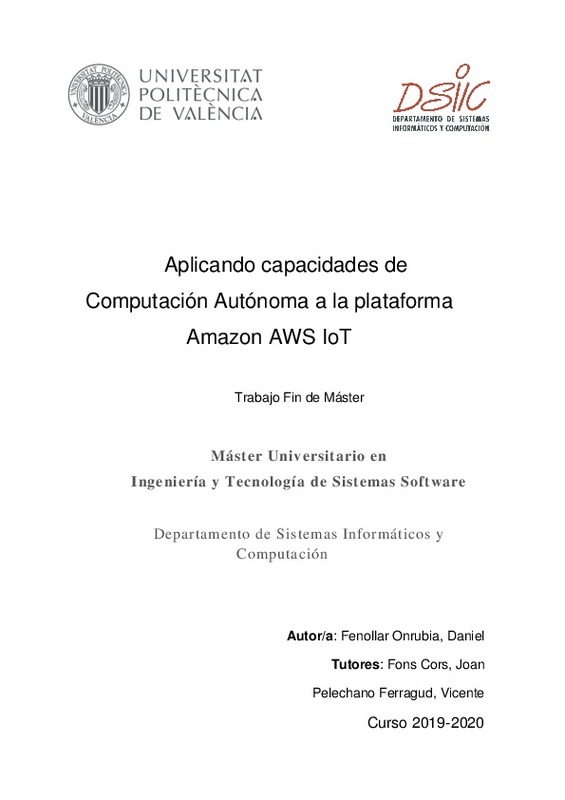JavaScript is disabled for your browser. Some features of this site may not work without it.
Buscar en RiuNet
Listar
Mi cuenta
Estadísticas
Ayuda RiuNet
Admin. UPV
Aplicando capacidades de computación autónoma a la plataforma Amazon AWS IoT
Mostrar el registro sencillo del ítem
Ficheros en el ítem
| dc.contributor.advisor | Fons Cors, Joan Josep
|
es_ES |
| dc.contributor.advisor | Pelechano Ferragud, Vicente
|
es_ES |
| dc.contributor.author | Fenollar Onrubia, Daniel
|
es_ES |
| dc.date.accessioned | 2021-01-25T07:44:36Z | |
| dc.date.available | 2021-01-25T07:44:36Z | |
| dc.date.created | 2020-12-10 | |
| dc.date.issued | 2021-01-25 | es_ES |
| dc.identifier.uri | http://hdl.handle.net/10251/159777 | |
| dc.description.abstract | [ES] El crecimiento de la computación móvil junto con la Internet de las Cosas está generando un aumento en la creación de dispositivos con mayores capacidades de comunicación y procesamiento. Esto lleva al desarrollo de soluciones informáticas ligadas a estos dispositivos físicos que nos permiten comunicar el mundo digital con el real, ya sea recopilando información o monitorizándolo. La naturaleza de las aplicaciones en este dominio es dinámica, es decir, se encuentra en cambio constante. Amazon ofrece una plataforma de computación en la nube para el desarrollo de este tipo de soluciones, denominada Amazon AWS IoT. Esta pone a nuestra disposición una serie de servicios que nos ayudan a configurar, desplegar y establecer mecanismos e interfaces para la comunicación entre los dispositivos físicos a través de distintas reglas, protocolos, tecnologías de comunicación, etc. Nos centraremos en el servicio de Gestión de Dispositivos (AWS IoT Device Management) y haremos uso del concepto de Shadow Device. Sin embargo, actualmente, la gestión y configuración de los dispositivos IoT, que interactuarán en una o varias aplicaciones, es fija. Es decir, solo se pueden realizar cambios manualmente, requiriendo que un desarrollador, operador o propietario de los mismos accedan y realicen dicha gestión. El objetivo del trabajo es identificar que extensiones realizar sobre la infraestructura para permitir el desarrollo de soluciones más flexibles en la plataforma y conseguir una configuración y gestión dinámica. Haciendo uso de técnicas de computación autónoma basadas en bucles de control, aplicados de manera conceptual. Finalmente, para la validación de la propuesta se describirán distintos escenarios donde aparezcan este tipo de necesidades, que no se pueden obtener con una solución AWS IoT actual. Desarrollando un pequeño prototipo funcional que simule el nuevo funcionamiento que la plataforma podría ofrecer tras la realización del proyecto. | es_ES |
| dc.description.abstract | [EN] The growth of mobile computing along with the Internet of Things (IoT) is generating an increase in the creation of devices with greater communication and processing capabilities. This leads to the development of computer solutions linked to these physical devices that allow us to communicate the digital world with the real one, either by collecting information or monitoring it. The nature of applications in this domain is dynamic, that is, it is constantly changing. Amazon offers a cloud computing platform for the development of these types of solutions, called Amazon AWS IoT. This puts at our disposal a series of services that help us configure, deploy and establish mechanisms and interfaces for communication between physical devices through different rules, protocols, communication technologies, etc. We will focus on the Device Management service (AWS IoT Device Management) and we will make use of the concept of Shadow Device. However, currently, the management and configuration of IoT devices, which will interact in one or more applications, is fixed. In other words, changes can only be made manually, requiring that a developer, operator or owner access and carry out said management. The objective of the work is to identify the extensions made on the infrastructure to allow the development of more flexible solutions on the platform and achieve dynamic configuration and management. Making use of autonomous computing techniques based on control loops, applied conceptually. Finally, for the validation of the proposal, different scenarios will be described where these types of needs appear, which cannot be obtained with a current AWS IoT solution. Developing a small functional prototype that simulates the new operation that the platform could offer after the completion of the project. | es_ES |
| dc.format.extent | 70 | es_ES |
| dc.language | Español | es_ES |
| dc.publisher | Universitat Politècnica de València | es_ES |
| dc.rights | Reserva de todos los derechos | es_ES |
| dc.subject | Servicios en la nube | es_ES |
| dc.subject | Amazon Web Services | es_ES |
| dc.subject | Internet de las cosas (IoT) | es_ES |
| dc.subject | Computación Autónoma | es_ES |
| dc.subject | Amazon AWS IoT | es_ES |
| dc.subject | Computación en la Nuble | es_ES |
| dc.subject | Autonomous Computing | es_ES |
| dc.subject | Cloud Computing | es_ES |
| dc.subject | Internet of Things (loT) | es_ES |
| dc.subject | Cloud services | es_ES |
| dc.subject.classification | LENGUAJES Y SISTEMAS INFORMATICOS | es_ES |
| dc.subject.other | Máster Universitario en Ingeniería y Tecnología de Sistemas Software-Màster Universitari en Enginyeria i Tecnologia de Sistemes Programari | es_ES |
| dc.title | Aplicando capacidades de computación autónoma a la plataforma Amazon AWS IoT | es_ES |
| dc.type | Tesis de máster | es_ES |
| dc.rights.accessRights | Abierto | es_ES |
| dc.contributor.affiliation | Universitat Politècnica de València. Departamento de Sistemas Informáticos y Computación - Departament de Sistemes Informàtics i Computació | es_ES |
| dc.description.bibliographicCitation | Fenollar Onrubia, D. (2020). Aplicando capacidades de computación autónoma a la plataforma Amazon AWS IoT. Universitat Politècnica de València. http://hdl.handle.net/10251/159777 | es_ES |
| dc.description.accrualMethod | TFGM | es_ES |
| dc.relation.pasarela | TFGM\132081 | es_ES |






